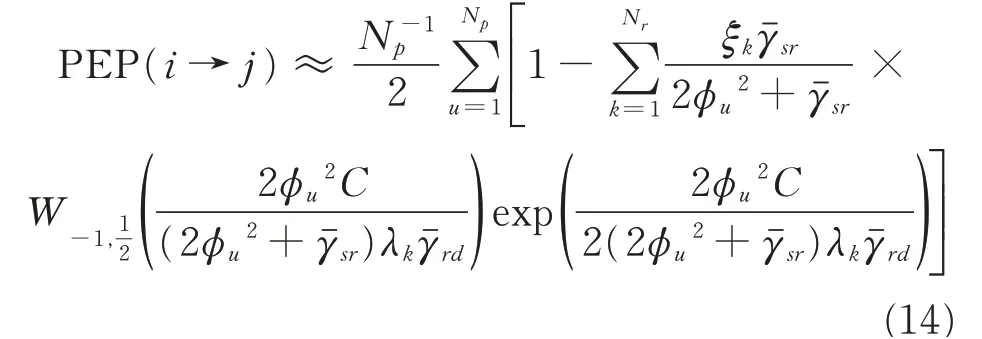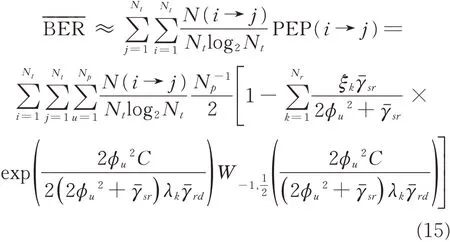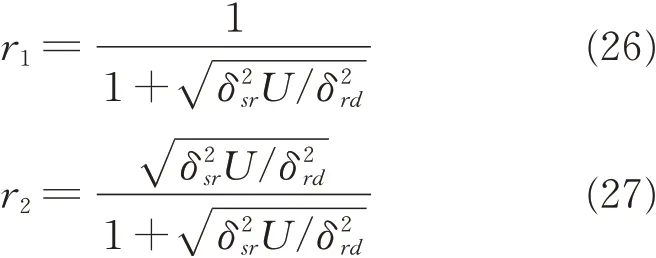Performance Analysis and Power Allocation for Cooperative SSK System with Receive Correlation in Rayleigh Fading Channel
2019-09-25YUXiangbinLIQiyishuHUYapingPanQing
YU Xiangbin,LI Qiyishu,HU Yaping,Pan Qing
College of Electronic and Information Engineering,Nanjing University of Aeronautics and Astronautics,Nanjing 210016,P.R.China
Abstract: In this paper,the performance analysis of cooperative space shift keying(SSK)system with dual-hop amplify and forward(AF)in receive-correlated Rayleigh channel is presented. By means of the performance analysis,a closed-form approximate expression of the average bit error rate(BER)is derived for the performance evaluation.With this expression,in a high signal-to-noise-ratio(SNR)region,a tight closed-form asymptotic BER of the system is also derived. It can simplify the calculation of average BER and provide effective evaluation for asymptotic performance. By minimizing this asymptotic BER expression,a suboptimum power allocation(PA)scheme is developed,and the closed-form PA coefficients are obtained. Simulation indicates that the suboptimal PA scheme outperforms the conventional equal PA scheme,and its performance is very close to that of the exhaustive search based optimal PA scheme but with low complexity. Moreover,the system performance under the spatially correlated channel is worse than that in spatially independent channel due to the effect of spatial correlation.
Key words: amplify and forward;space shift keying;receive correlation;power allocation
0 Introduction
Cooperative communications have been investigated extensively thanks to its abilities to reduce the error probability,increase the coverage and enhance the capacity of wireless communication system[1].One of the fundamental transmission protocols is amplify and forward(AF)relaying strategy,in which the relay only amplifies and retransmits the signals received from the source.As a simple and effective cooperative protocol,AF relaying has gained a lot of attention.
Space shift keying(SSK)is a spectrally efficient and low-complexity technique,and it offers a good solution to trade-off between the complexity and data rate. In SSK,the information bits are conveyed in spatial domain,so only one radio frequency(RF)chain is used during each transmission.Therefore,inter-channel interference and antenna synchronization will be eliminated. A novel relay selection strategy for cooperative SSK systems was presented in Ref.[2],and the corresponding error performance was analyzed. With transmit antenna selection adopted at the source,the performance of the multiple-relay assisted SSK system can be further improved,and the theoretical bit error rate(BER)expression of the proposed SSK system was derived[3].Combining the advantages of both cooperative communication and SSK,cooperative SSK has been widely investigated. In Refs.[4-5],SSK with cooperative relay was introduced,and the closed-form expression for average BER was given.In Ref.[6],BER performance of SSK with decode and forward(DF)protocol was analyzed,and an exact analytical expression for the end-to-end BER was derived. Moreover,the error performance of the single relay aided SSK system using hybrid decode AF cooperative protocol was analyzed in Ref.[7],and the corresponding BER expression was derived in closed form. The proposed relaying scheme was also compared with other relaying protocols such as AF relaying and DF relaying,and simulation results show the superiority of the proposed relaying scheme to the one with AF(DF)relaying.
System designs often assume that the fading is independent,however,spatial correlation among the antenna elements exists in many practical situations due to the physical space constraints and poor scattering conditions. The performance of SSK systems was analyzed in Ref.[8]for correlated fading channel,and the corresponding theoretical BER was derived. In Ref.[9],an optimal power allocation scheme was developed for spatial modulation system with DF cooperative protocol over the correlated fading channels. However,none of the aforementioned research involves the error performance and power allocation scheme for SSK system with AF relaying over Rayleigh fading channels in the presence of receive correlation.
Based on the analysis above,in this paper,we study the performance of the dual-hop relay-aided AF-SSK system over receive correlated Rayleigh channel. First,we give the system model of AFSSK and derive a closed-form expression of the moment-generating function (MGF) for effective SNR. With this result,the average pairwise error probability(APEP)can be derived and the average BER is obtained by means of the upper bound formula. After that,we analyze the asymptotic performance of the system under high SNR,and provide asymptotic BER expression. Based on this,the diversity gain of the system is derived. By minimizing the asymptotic BER expression,a suboptimal PA scheme is proposed,and closed-form PA coefficients are attained. Simulation results illustrate that the presented theoretical analysis and PA scheme are effective. The derived theoretical BER and asymptotic BER can match the corresponding simulations well,and the proposed PA scheme performs better than the conventional equal power scheme since the power are well allocated in terms of channel information.
Notation:[·]T,[·]Hrepresent the matrix transposition and conjugate transposition,respectively.(0,δ2) denotes a complex Gaussian distribution with zero-mean and variance δ2.Cm×ndenotes the complex-valued matrix with dimensions m × n. INrepresents the identity matrix with dimensions N × N.Pr {·} is the probability of an event.E [·] indicates the expectation operation.is the Frobenius norm.Re{·}stands for the real part of a variable.
1 System Model
As shown in Fig.1,we consider a dual-hop AFSSK system. It includes a source(S)terminal and a destination(D)terminal with Nttransmit antennas and Nrreceive antennas,respectively,and there is a relay(R)terminal with single antenna. We suppose that the communication link between the source and destination is only established via the relay terminal due to their larger distance. The channel vectors between the S-R are given by hsr∈C1×Nt,and the channel vectors between the R-D is given by hrd∈CNr×1. The entries of the above vectors are independent and identically distributed.They are complex Gaussian random variables with,where,mn ∈{ sr,rd },dmnrepresents the normalized distance between the terminals m and n,and α is the pass loss. In SSK scheme,only one transmit antenna is activated,and log2Ntbits will be conveyed at each time slot.Thus,the transmitted signal can be described as x=ei,where eiis the ith column of INt,and i denotes the index of the selected transmit antenna.

Fig.1 Dual-hop AF-SSK system model
Consider the dual-hop AF-SSK system with correlation at the destination terminal only,characterized by a receive correlation matrix Rd. A typical scenario for this is a downlink transmission,where the antennas at base station(i.e.,source terminal)can be easily spaced far enough to achieve spatial uncorrelation. But for user(destination)terminal,the antennas will exhibit spatial correlation due to smaller antenna spacing which is from the limited volume and size of user terminal. When the correlation among the receiving antennas exists,according to the Kronecker correlation model[10-12],the channel vector between the relay and destination is expressed as hrd=,the elements in Rdare writt en asfor vand ρrrepresents the correlation coefficient at the destination.
Based on the above analysis,the received signal at the relay is given by

where Psis the transmitted power at the source,represents the i-th element of hsr,and nsris a zeromean complex Gaussian random variable with variance N0. Then,the relay with AF protocol amplifies and forwards the signal ysr,and the received signal at the destination is expressed as


The colored Gaussian noise n can be whitened by pre-multiplying Σ-1/2n, where Σ-1n=INr-After whitening process,we can obtain

The maximum likelihood(ML) detection is employed at destination. From Eq.(4),the estimated antenna index j is calculated by


With this detector,the transmit antenna index can be optimally detected.
2 Performance Analysis and Average BER
The error performance of the AF-SSK system is analyzed in this section,and an approximate closed-form BER expression is derived.
According to Eq.(5),the conditional PEP is expressed as



With Eq.(8) and using the inverse Laplace transform,the probability density function(PDF)of γrdis obtained as

On the other hand,the PDF of γsrfollows the exponentially distribution. Therefore,its cumulative distribution function(CDF)is given by


where K1(·) is the first order modified Bessel function of the second kind[13]. Then the MGF of γsrdcan be derived as

where Wλ,μ(z) is the Whittaker function[14]. The average PEP can be computed with Craig's formula[15]

where φu=cos((2u-1)π/(2Np)),and Npis the order of the Chebyshev polynomial. Substituting Eq.(12)into Eq.(13)yields

With Eq.(14),the average BER can be approximately obtained by using the union bound as Ref.[16].Namely

3 Asymptotic BER and Power Allocation
In this section,we will give the asymptotic BER analysis under high SNR scenario,and a suboptimal power allocation scheme is developed by minimizing the asymptotical BER approximation under a total transmit power constraint.
3.1 Asymptotic BER analysis and diversity gain
According to the approximated expression of the Bessel function given in Ref.[14],for sufficiently small x,K1(2x) can be approximately written as

where ψ( ·) is digamma function,lnΓ(x). In addition,when the SNR goes to infinity,we have C/γˉsr≈1,and the CDF of γsrdis written as

where the relation(a)is obtained with the aid of the approximations exp()≈1-γand exp(-1 successively. Thus,the MGF of γsrdis obtained as

Substituting Eq.(18)into Eq.(13),the average PEP is approximated as

Let Ptbe the total transmission power,i.e.,Pt=Ps+Pr,= Pt/N0denotes average SNR.Thus, we can assume that Ps= r1Ptand Pr= r2Pt, where r1+ r2= 1,r1,r2∈(0,1). r1and r2represent power allocation coefficients at the source and the relay. Based on this assumption,can be obtained. Utilizing the partial fraction expansion, we have,and it can be further derived thaby setting s=0. Consequently,Eq.(19)can be further written as

With Eqs.(15)and(20),the asymptotic approximate BER expression of the system at high SNR is given by

According to the definition of diversity gain,it is the slope of the line representing the BER at high SNR with log-log scale. Thus,the diversity gain is derived as

3.2 Power allocation scheme
Based on the asymptotic BER expression in Eq.(21),we will develop a suboptimal PA scheme with closed-form expression of PA coefficients.Take the first and second derivatives with respect to r1yields


Based on the analysis above,BERasywill have a unique minimum for r1∈[0,1]. This is becauseand g′(r1)>0. By setting g(r1)=0,r1and r2can be calculated as

Eqs.(26)and(27)are PA coefficients of suboptimal scheme,and with these coefficients,the suboptimal scheme will gain the superior BER performance.
4 Simulation Results
In this section,we will provide simulation results to assess the validity of the presented theoretical analysis and PA scheme for AF-SSK system with spatially receive correlated Rayleigh channel.The number of transmit antennas Nt= 2,the order of the polynomial Npis set as 5,and the path-loss exponent α=3.
In Fig.2,we plot the BER performance of the AF-SSK system with different correlation coefficients. The number of transmit and receive antennas are considered as the same,i.e.,Nt= Nr= 2,the distance between the source and destination is normalized to one,and dsr∶drd=0.2 ∶0.8. The receive correlation coefficient ρris set equal to 0.1,0.5,and 0.9. The theoretical BER is calculated by Eq.(15). The result implies exact matches between the theoretical analysis and the corresponding simulations. Besides,average BER decreases with SNR increasing,as expected. Moreover,as the correlation coefficient increases,the BER increases accordingly. Namely,the BER performance of the system with ρr=0.9 is worse than that with ρr=0.5 due to the effect of strong correlation,and the BER performance of the system with ρr=0.5 is worse than that with ρr=0.1.

Fig.2 Average BER of AF-SSK system with different correlation coefficients

Fig.3 Average BER of AF-SSK with different receive numbers
Fig.3 illustrates the BER performance of AFSSK system with different receive numbers,where the distance between different terminals is given by dsr∶drd=0.2 ∶0.8,and the receive correlation coefficient ρris set as 0.5. The curves of simulated BER,theoretical BER and asymptotical BER are plotted in Fig.3. The asymptotical BER is computed by Eq.(21). As shown in Fig.3,the theoretical BER agrees well with the simulated one. Moreover,the asymptotical BER has the values very close to the corresponding simulation from medium SNR to high SNR. Especially at high SNR region,it can match the simulation very well. By comparison,it is found that average BER of the system with Nr=6 is lower than that Nr=2 because more antennas are employed. Besides,the curves of Nr=6 are asymptotically parallel with those of Nr=2,which means that they have the same diversity order.Namely,the diversity order of one is achieved.
In Fig.4,we give the simulated and theoretical BER curves of the AF-SSK system using different PA schemes,where the conventional equal PA scheme,proposed suboptimal PA scheme and optimal PA scheme are compared. The optimal PA scheme is obtained via the exhaustive search method to minimize the average BER of Eq.(15). The related parameters are set as Nr=2, ρr=0.5, and dsr∶drd=0.2 ∶0.8. It is shown that the system with suboptimal scheme exhibits superior performance over that with the equal PA scheme,and is very close to that with the optimal PA scheme.However,the optimal scheme has much higher complexity than the suboptimal scheme since it needs to use the exhaustive search to obtain the PA coefficients,while the latter can provide the closed-form computation of PA coefficients.Besides,the asymptotic BER curves still agree with the corresponding simulations at high SNR region due to better asymptotic characteristic.

Fig.4 Average BER of AF-SSK with different PA schemes
Fig.5 illustrates the BER performance of the AF-SSK system with three PA schemes for different distances between terminals,where the related parameters are listed as Nr=2 and ρr=0.5.dsr∶drd=0.2 ∶0.8 and dsr∶drd=0.5 ∶0.5 are considered in Fig.5(a),dsr∶drd= 0.5 ∶0.5 and dsr∶drd=0.8 ∶0.2 are considered in Fig.5(b). It is observed that,for three PA schemes,the BER performance of the system with dsr∶drd=0.5 ∶0.5 outperforms that with dsr∶drd=0.2 ∶0.8 and that with dsr∶drd=0.8 ∶0.2. Moreover,when relay gets closer to the source or destination,the superiority of the proposed scheme over the equal power allocation is more obvious. Whereas when relay is closer to the middle position between the source and destination,the proposed scheme has the performance very close to that of equal PA scheme. The results indicate that the proposed scheme is more suitable for the case that dsris very different with drd.Besides, the proposed suboptimal scheme can achieve almost the same BER performance as the optimal scheme while maintaining low complexity.

Fig.5 Average BER of AF-SSK with different relay locations
5 Conclusions
We have investigated the BER performance of the dual-hop AF-SSK system with receive correlation over Rayleigh fading channels. An approximate expression of average BER for the system is derived in a closed form. Then,based on the asymptotical analysis at high SNR,the asymptotic BER expression is also derived,and it can match the corresponding simulation well at high SNR region. With this expression,diversity gain is derived and a suboptimal PA scheme is developed. It is shown that the proposed PA scheme exhibits noticeable performance gain over the conventional equal PA scheme,and it has almost the same performance as the optimal PA scheme based on exhaustive search method while maintaining lower complexity. Simulations validate the accuracy of the presented theoretical analysis and PA scheme. The impact of relay location on the system BER performance is also analyzed. The result indicates that the relay gets closer to the source or the destination,and the suboptimal PA scheme will achieve a greater improvement over the equal PA scheme. Besides,due to the effect of spatial correlation,the system performance will degrade with the increase in the receive correlation coefficient,as expected.
杂志排行
Transactions of Nanjing University of Aeronautics and Astronautics的其它文章
- Retro-reflective Beamforming Technique with Applications in Wireless Power Transmission
- A 60 GHz Phased Array System Analysis and Its Phase Shifter in a 40 nm CMOS Technology
- Design of Power Amplifier for mmWave 5G and Beyond
- MoM-PO/SBR Algorithm Based on Collaborative Platform and Mixed Model
- Low-Complexity DOA Estimation of Noncircular Signals for Coprime Sensor Arrays
- A Generative Adversarial Nets Method for Monitoring Data Generation on Aircraft Engines
